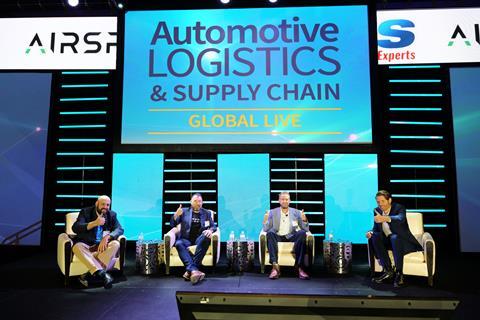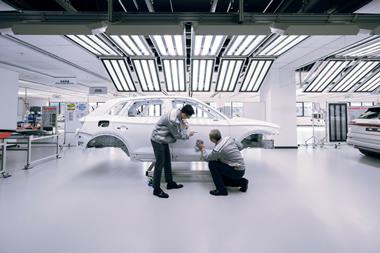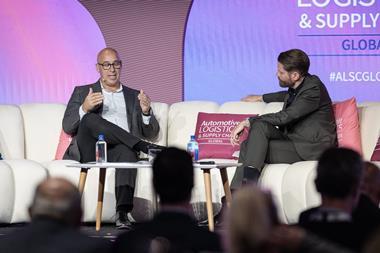The automotive industry has faced a perfect storm of troubles over the last 18 months. Namely, a year of global shutdowns resulting from the coronavirus pandemic, bottlenecks, labour shortages, and a deficit in semiconductors. This has shone a light on the once inconspicuous drudgery of logistics providers who make the commercial world go around.
As the automotive industry faces continuing turbulence, a barrage of technical solutions have been held aloft as remedy to global logjams but logistics leaders have also stressed that building and strengthening partnerships is essential to navigating ongoing disruptions in global supply chains.
Addressing the Automotive Logistics and Supply Chain (ALSC) Global Live conference last week, John Andrew Carmichael, global head of automotive at shipping company A.P Moller Maersk, highlighted how logistics systems needed to modernise and that the supply chain and logistics crisis currently affecting the industry has “put into perspective” how outdated certain legacy systems were.

“It seems that, from a manufacturing perspective, things are very integrated,” he said. “There is codesign and co-development, but when you look at logistics has been left more of an optimisation game, product-by-product.”
This comes as global supply chains are more exposed than ever, resulting from container constraints and reduced network capacities from rising costs and longer lead times. Automakers and tier suppliers are now rethinking and adapting their operations.
Marcus Bennett, CEO of Quick International Courier, said that the logistics provider had invested heavily in predictive analytics, AI and machine learning. That was helping transparency and communication throughout the tier supplier network, something that was key to dealing with the crisis.
“Having meaningful relationships with your customers and trying to work on this partnership approach definitely helps,” said Bennett. “[However], we find getting traction with our customers slightly difficult sometimes because everyone is constrained [and unclear] about what’s going on.”
Meaningful conversations
Bennett stressed that, along with digital technology tools, the most meaningful solutions come from sitting down and talking to customers to understand their ever-changing pain points, whether that be freight delays, labour shortages, or a myriad of other issues. Better understanding means that logistics providers are working in tandem with their customers to solve problems.
“The more engagement we have and the more proper conversations around the data they have… helps us provide more meaningful solutions,” he said, adding the importance of speaking with one voice to the customer. “We do have some challenges with our customers around the quality of the data but you’re never going to get it 100% right, so I’d encourage customers to lean into conversations and let us script potential solutions around all of that.”
Carmichael agreed that tackling challenges in the supply chain depended on cementing communication with partners to get a full picture on which to act.
“From our perspective, a lot of our time is based on how we can improve schedule reliability by doing quite a few things: getting more vessels into problem areas, trying to work with authorities on getting a faster discharge… and getting the right amount of labour,” he said.
Maersk is beginning to look at intercontinental transport through a wider lens, including studying the data on assets and capabilities, and not just focusing on the transit times between container yards, according to Carmichael.
“It’s that change in mindset that service providers we need have because it’s not good enough to look at just one portion of the transportation network,” he said. “What we’ve been focusing on is on the partnership side – the customers we are working with – and how we can improve our service offerings… to support them [with better services] during these hard times. The partnership angle is definitely the key for improving our service at the moment.”
Fellow panelist Ryan Etherton, the senior manager of transportation and logistics at American Axle & Manufacturing (AAM), also noted that partner communication was a major focus in the current climate.
“We’ve really made an effort to leverage our partnerships with our partners, having much more frequent conversations, meetings, reviews,” he said. “We are including in these conversations, for example, weekly reviews of everything that’s in transit. Also, looking at making sure that all of our future forecasts have bookings around them so we’re not losing something [because it has no] visibility.”
Etherton said that bringing material planners in on the discussions and making them aware of the conditions was a good move because a lot of the time they were left out and it was very important that everyone from end-to-end supply chain is acutely aware of what’s going on.
Creative solutions
Etherton also pointed to the importance of creativity and thinking beyond the status quo as a means by which logistics providers could circumnavigate supply chains problems. That could be through new hybrid multimodal combinations involving sea, air, road and rail for better cost and efficiency in what is already a chaotic situation.
“Whatever we used to do is not working today, so it’s really just being as creative as possible, sometimes challenging our forwarders for a crazy option and exhausting it,” he said. “At the end of the day, the worst thing we can do is not meet those commitments we made to our customers.”
At the same time, there needs to be better data integration to provide customers with the most accurate information and enable them to plan better.
“We’ve made a concerted effort to make sure that we’re giving our volumes of schedules,” said Etherton. “Now we’re planning four-to-six weeks out no matter what, to make sure we’re getting our allocations, we’re getting our bookings.”
Speakers at the conference agreed that the process of establishing high-levels of trust and a mutual understanding of processes had to take place alongside material changes in logistics and the adoption of the technology being used to tackle the disruption.

























No comments yet